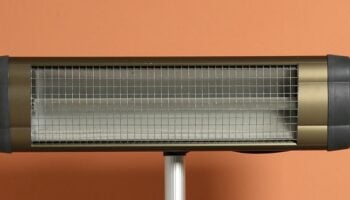We've independently reviewed this article to make sure it's as accurate as we can make it.
To find out more about our article creation and review process, check out our editorial guidelines.
If you own or are considering underfloor heating, the cost of running the system can cause a lot of hesitation.
After helping a friend install underfloor heating for their home, I wanted to give a definite answer to this question. So I went ahead and created a full calculator to work out the cost of running an underfloor heating system.
Here’s the calculator – simply change the inputs for to match your system, and it’ll tell you just how much your underfloor heating system will cost to run.
If you’re stuck on any of the inputs, keep reading for a full explanation on how to use the calculator!
Average Cost to Run An Underfloor Heating System
On average, an underfloor heating system will cost around $1.20 per hour to run. This is based on a heating area of 80 square feet and maximum heating power. The actual cost to run a system varies greatly depending on the area of the system, the power, and the cost of electricity.
I hope the calculator above will allow you to quickly estimate your own personal cost estimates, and figure out whether an underfloor system is worth it for your home.
I’ll give you a brief overview of how to use the calculator and then address some other things such as whether or not underfloor heating uses a lot of electricity and more. So keep reading!
How to Use the Underfloor Heating Cost Calculator
The calculator is fairly self-explanatory, but here is a quick walk through.
First, you are going to need to find out the wattage rating on the underfloor heating you have or you are thinking of buying. And determine whether you would typically run your heating at a high or low setting since this will impact the wattage used.
Typical wattage is generally in the 7 to 15 watt per square foot range, but it’s probably a good idea to have exact amounts.
You’ll also need to know your local kWh costs. To make things easier for you, I’ve created a free calculator based on EIA information that can help you determine the electricity cost of your state. Click here to check it out!
The last thing you’ll need to know to calculate how much it costs to run underfloor heating is the number of hours a day you expect to run it.
Once you have entered all the required data, it will provide you with your estimated costs—and you didn’t even need to do much math. Which is always a bonus in my opinion.
But now that you know the cost to run underfloor heating, what about the other questions people often have?
Let me address some of them too.
Do Heated Floors Use a Lot of Electricity?
Well, that depends.
Sorry, you probably hate that answer as much as I hate giving it, but the truth is there are a lot of variables involved. And the biggest variable is likely how much floor space you are thinking of heating. Obviously, a small bathroom is going to cost less to heat than a large, eat-in, family kitchen.

Additionally, are you looking to add underfloor heating to supplement the heat in a few rooms, or are you looking to heat your whole home?
Either way, there are three bits of info you want to keep in mind.
- The square footage you want to cover
- The amount of wattage per square foot. Let’s keep it simple and say 7 watts per sq. ft. on low or 15 watts per sq. ft. on high.
- And lastly, your local KWh cost for electricity.
If you want to provide underfloor heating to a 100 square foot room on high, it’s going to cost you about the same it will cost you to run a 1,500 watt for on high for the same amount of time.
If you want to heat an 1,800 sq. ft. home 24 hours a day, it would cost you nearly $100 a day. Ouch. But remember, chances are you’re not going to run it that long, and as you’ll see below, there are flooring options that will retain heat. So keep those 2 factors in mind if you’re looking at heating an entire home with underfloor heating.
If you’re only looking at supplemental heating for a few rooms, consider this:
In the heat of summer, with no air conditioning, do you think twice about running one or more fans in your home for several hours at a time? Probably not. So it all comes down to your comfort. Would you pay the same in winter to keep your feet warm? Only you can answer that.
And let me point out that the standard size kitchen is 8 feet by 10 feet—less than 100 square feet. So we could theoretically say that your underfloor heating costs would be less than it would cost you to run a fan—under certain conditions.
The Pros & Cons of Underfloor Heating
First up, let’s talk about the flooring you want to put over your underfloor heating. Because you may find that your favorite flooring isn’t the best option to pair with underfloor heating.
Flooring Options that Don’t Pair Well with Underfloor Heating
Carpet. Since carpet has insulating properties, putting it over underfloor heating kind of defeats the purpose. It will actually prevent the heat from radiating through the floor and into your living space.
This doesn’t mean you can’t use rugs at all. A few smaller area rugs are fine, but you should stay away from larger rugs and wall-to-wall carpeting.

Vinyl Flooring. Heat may cause your vinyl to either discolor or off-gas. Both things you would want to avoid.
Hardwood. Since wood is sensitive to temperature changes, as well as the amount of moisture in the air, your beautiful, expensive flooring could buckle, swell, or shrink.
The Best Flooring Options to Pair with Underfloor Heating
Engineered Wood. If you prefer hardwood flooring, this is your best bet. It looks like solid wood since the top layers are solid wood. However, the bottom layers are made out of a base that will not react to heat.
Laminate. Like engineered wood, laminate is made out of layers, but the top layer isn’t real wood. It’s simply a replica. However, it works well over underfloor heating, and it will not expand or contract.
Natural Stone. If you’ve ever stood on a stone patio in the middle of summer in your bare feet, you know stone will hold and conduct heat. This makes it a great choice to use over underfloor heating.

Tile. Both porcelain and ceramic conduct heat, just like stone. And since heat won’t make it expand or contract, you will never need to worry about it cracking—at least not from heat.
Vinyl Planks. LVP or luxury vinyl planksare a popular choice with underfloor heating thanks to their rigid core technology, just be sure to check the manufacturer’s maximum temperature rating.
Pros of Underfloor Heating
- Constant, even temperatures
- Quiet
- Maintenance free
Let’s flesh that out a bit.
Even in the case of a short power outage, you are assured constant, stable room temps since radiant underfloor heating stores heat and still disperses it later. However, this will depend on the type of flooring you use.
The other benefit is the way your heat is distributed. It’s rising through every square foot of your flooring, not blowing at you from one or two spots in a room.
Underfloor heating is silent. Even if you have a state-of-the-art furnace, you can still hear it. You can also hear your ducts expanding and contracting.
For the most part, you switch on your underfloor heating and let it be. It doesn’t need to be serviced regularly, and you don’t need to change filters and so on.
Cons of Underfloor Heating
It can’t all be good, unfortunately.
- Upfront costs
- Doesn’t work under all flooring choices
- If your home needs cooling as well, it really isn’t the best option
Again, let’s get a bit deeper.
The cost for materials and installation of underfloor heating can be from about $2,000 to $5,000. And depending on the contractor you hire—assuming you aren’t installing yourself—it could be even more.
I’ve already discussed flooring choices above, so I won’t go over that again.
If you live somewhere where you need both heating and cooling throughout the year, and you’re thinking of using underfloor heating for the whole home, not a room or two, you should probably consider another heating method. You can get radiant cooling, but it’s typically installed on the ceiling, so you’re looking at two units to purchase and install.
Conclusion
So there you have it. We’ve provided you with a handy calculator and showed you how to use it—and even how to do your own manual calculations.
And hopefully, the additional information was helpful as well. You know that you can use a 1500-watt fan as a comparison when determining how much it will cost, and what flooring choices are the best to use in conjunction with underfloor heating.
Thanks for looking to us to answer your questions! Why not browse the related articles below? Perhaps we can help you with something else.







